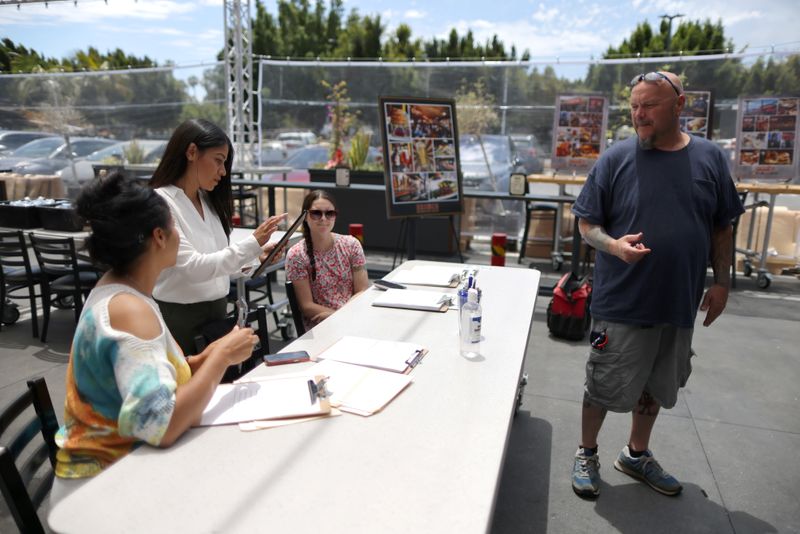By Lucia Mutikani
WASHINGTON (Reuters) - The number of Americans filing new claims for unemployment benefits fell more than expected last week, while layoffs plunged to a 21-year low in June, suggesting the labor market recovery from the COVID-19 pandemic was gaining traction.
But a shortage of willing workers is hampering hiring, with other data on Thursday showing a measure of employment at factories contracting in June for the first time in seven months. Manufacturers said they were experiencing "difficulty in hiring and retaining direct labor," the Institute for Supply Management (ISM) said in its survey of national factory activity, noting that these challenges "across the entire value chain continue to be the major obstacles to increasing growth."
One respondent in primary metals said "lack of labor is killing us."
The data was released ahead of Friday's closely watched employment report for June, which according to a Reuters survey of economists will likely show nonfarm payrolls increasing by 700,000 jobs last month after rising by 559,000 in May. The unemployment rate is forecast to tick down to 5.7% from 5.8%.
The economy is experiencing a boom in demand following a reopening made possible by vaccinations against the coronavirus, with more than 150 million Americans fully immunized.
"America's back to work and an important milestone was reached where new claims are back below the 400,000 barrier after a hiccup at the start of June," said Chris Rupkey, chief economist at FWDBONDS in New York. "Summer is always the strongest season for hiring each year, and this year is no exception."
Initial claims for state unemployment benefits dropped 51,000 to a seasonally adjusted 364,000 for the week ended June 26, the Labor Department said. That was the lowest number since March 2020, when mandatory shutdowns of nonessential businesses were enforced to slow the first wave of COVID-19 infections.
The improvement in claims had appeared to stall in mid-June. Though claims remain above the 200,000-250,000 range that is viewed as consistent with a healthy labor market, they have tumbled from a record 6.149 million in early April 2020.
Economists polled by Reuters had forecast 390,000 applications for the latest week. There was a big decline in filings in Pennsylvania, which reversed the prior week's surge. The state last month upgraded its filing system, and the transition could be causing volatility in the data. There were also large drops in claims in California, Kentucky and Texas.
Graphic: Jobless claims - https://graphics.reuters.com/USA-STOCKS/dgkplrlazpb/jobless-claims.png
The claims data could become noisy in the weeks ahead as 25 states with mostly Republican governors pull out of federal government-funded unemployment programs, including a $300 weekly check, which businesses complained were encouraging the jobless to stay at home. The early termination began on June 5 and will run through July 31, when Louisiana, the only one of those states with a Democratic governor, ends the weekly check.
For the rest of the country, these benefits will lapse on Sept. 6. There is no evidence so far of a surge in job searches in the 20 states that have already ended the federal benefits.
A survey this week by job search engine Indeed https://www.hiringlab.org/2021/06/29/indeed-job-seeker-survey-june-2021 found that while the vast majority of the unemployed indicated they would like to start looking for work in the next three months, many did not express a sense of urgency. But rising vaccinations, dwindling savings and the opening of schools in the fall will be key to pulling them back into the labor force.
The claims report showed the number of people continuing to receive benefits after an initial week of aid rose 56,000 to 3.469 million during the week ended June 19. There were 14.7 million people receiving benefits under all programs in mid-June, slightly down from 14.8 million early in the month.
Stocks on Wall Street were trading mostly higher. The dollar edged up against a basket of currencies. U.S. Treasury prices fell.
EMPLOYEE POACHING
In a separate report on Thursday, ISM said its index of national factory activity slipped to 60.6 last month from 61.2 in May. A reading above 50 indicates expansion in manufacturing, which accounts for 11.9% of the U.S. economy.
A measure of factory employment contracted for the first time since November. Companies reported hiring or attempting to hire. A significant number reported "employee turnover due to wage dynamics in the markets," ISM's Timothy Fiore said.
Graphic: ISM PMI - https://graphics.reuters.com/USA-STOCKS/nmopaxqdrva/ismpmi.png
"It appears that companies are paying up to steal workers from other firms," said Conrad DeQuadros, senior economic advisor at Brean Capital in New York.
Lack of affordable child care and fears of contracting the coronavirus have also been blamed for keeping workers, mostly women, at home. There were a record 9.3 million job openings at the end of April and 9.3 million people were officially unemployed in May.
A third report from global outplacement firm Challenger, Gray & Christmas showed job cuts announced by U.S.-based employers tumbled 16.7% to 20,476 in June, the lowest level since June 2000. Layoffs plummeted 88% compared to June 2020.

There were 67,975 job cuts in the second quarter, the fewest since the April-June period in 1997. In the first half of this year, layoffs dropped 87% to 212,661, the lowest total for the January-June period since 1995.
"We're seeing the rubber band snap back," said Andrew Challenger, senior vice president at Challenger, Gray & Christmas. "Companies are holding on tight to their workers during a time of record job openings and very high job seeker confidence. We haven't seen job cuts this low since the Dot-Com boom."